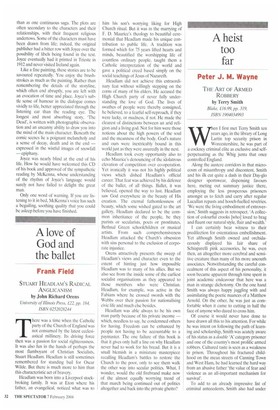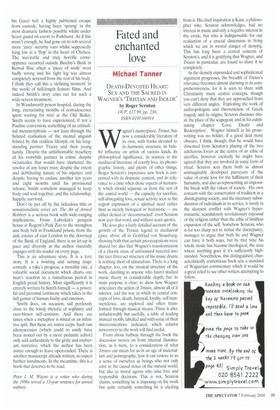A heist too far
Peter J. M. Wayne
THE ART OF ARMED ROBBERY by Terry Smith Blake, £16.99, pp. 319, ISBN 1904034993 WLen I first met Terry Smith ten years ago, in the library of Long artin top security prison in Worcestershire, he was part of a cockney criminal elite as exclusive and selfperpetuating as the Whig junta that once controlled England.
Along the austere corridors in that microcosm of misanthropy and discontent, Smith and his ilk cut quite a dash in their Day-glo designer sportswear, dispensing favours here, meting out summary justice there, employing the less prosperous prisoners amongst us to fetch and carry after regular Lucullan repasts and hooch-fuelled revelries. 'We were the living embodiment of extroversion,' Smith suggests in retrospect. 'A collection of colourful crooks [who] loved to brag and flaunt our natural style, flair and wealth.'
I can certainly bear witness to their predilection for ostentatious embellishment. Yet although Smith owned and orchidaceously displayed his fair share of Schiaparelli pink accessories, he was, even then, an altogether more cerebral and sensitive creature than many of his more uncouth associates. Notwithstanding the careful concealment of this aspect of his personality, it soon became apparent through time spent in joint academic endeavour that here was a man in strange dichotomy. On the one hand Smith was always happy juggling with and assimilating the poetic nuances of a Matthew Arnold. On the other, he was just as comfortable when it came to cutting in half the face of anyone who dared to cross him.
Of course it would never have done to have drawn all this to his attention. For while he was intent on following the path of learning and scholarship, Smith was acutely aware of his status as a double 'A' category prisoner and one of the country's most prolific armed robbers. Cultured taste is seen as a weakness in prison. Throughout his fractured childhood on the mean streets of Canning Town and West Ham, he had learned the hard way from an abusive father 'the value of fear and violence as an all-important mechanism for survival'.
To add to an already impressive list of criminal antecedents, Smith also had under his Gucci belt a highly publicised escape from custody, having been 'sprung' in the most dramatic fashion possible whilst under heavy guard on escort to Parkhurst. As if this wasn't enough, he had gone on to rob several more 'juicy' security vans whilst supposedly lying low at a 'flop' in the heart of Chelsea. The inevitable and truly horrific comeuppance occurred outside Barclay's Bank in Kensal Rise when a 'piece of work' went badly wrong and his right leg was almost completely severed from the rest of his body. I think they call this a 'defining moment' in the world of full-length feature films. And indeed Smith's story cries out for such a wide-screen treatment.
In Wandsworth prison hospital, during the long, excruciating months of convalescence spent waiting for trial at the Old Bailey, Smith seems to have experienced, if not a Pauline conversion, something of an attitudi nal metamorphosis — not least through the belated realisation of the mental anguish foisted by this reckless lifestyle on his long standing partner Tracey and their young family. Despite the unfathomable treachery of his erstwhile partner in crime; despite vicissitudes that would have shattered the resolve of any lesser man; despite the extent and debilitating nature of his injuries; and despite having to endure another ten years and eight months until his provisional release, Smith somehow managed to keep body and soul together, and the relationship, happily, survived, Don't be put off by the ridiculous title or sensationalistic cover art. The Art of Armed Robbery is a serious book with wide-ranging implications. From Lubetkin's penguin house at Regent's Park Zoo to the strongbox and body belt in Frankland prison, from the sink estates of east London to the doorstep of the Bank of England, there is no let-up in pace and diversity as the author viscerally engages with his reader on every page.
This is an adventure story. It is a love story. It is a twisting and turning tragi comedy, a rake's progress, a morality tale, a valuable social document which charts one man's reaction to a tumultuous period in English penal history. Most significantly it is entirely written by Smith himself — a powerful and personal testimony which takes in the full gamut of human frailty and emotion.
Smith does, on occasion, sail perilously close to the windy rhetoric of sophistry and over-blown self-centrism. And there are times when a metaphor is mixed or an infinitive split. But these are minor carps. Such raw idiosyncrasies (which could so easily have been ironed out by a more pedantic editor) only add authenticity to the gritty and exuber ant narrative, which the author has been astute enough to leave open-ended. There is another manuscript already written, so expect further instalments. In the meantime, this is a book that deserves to be read.
Peter .I. M Wayne is a writer who during the 1990s served a I3-year sentence for armed robbery.



























































 Previous page
Previous page